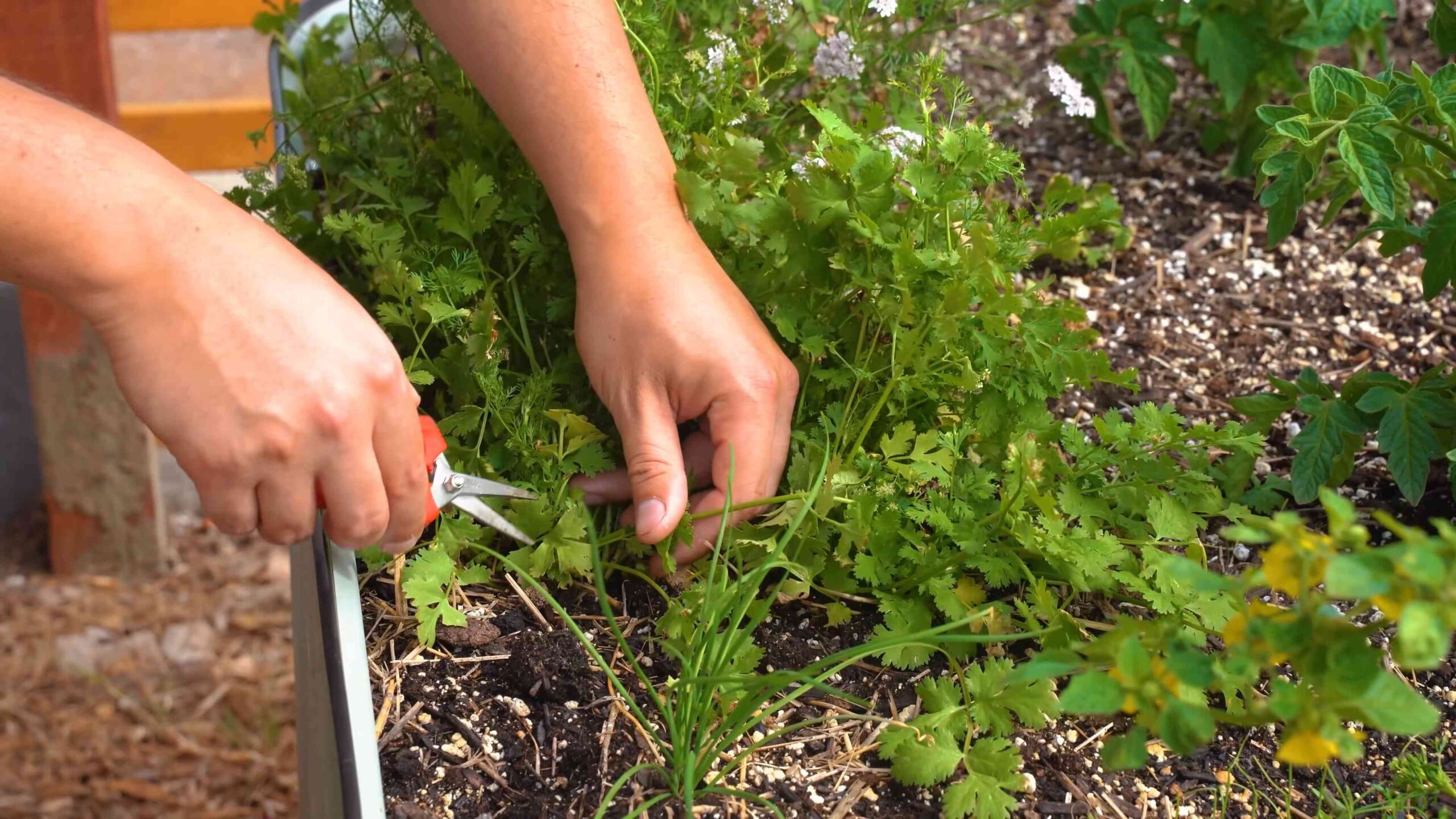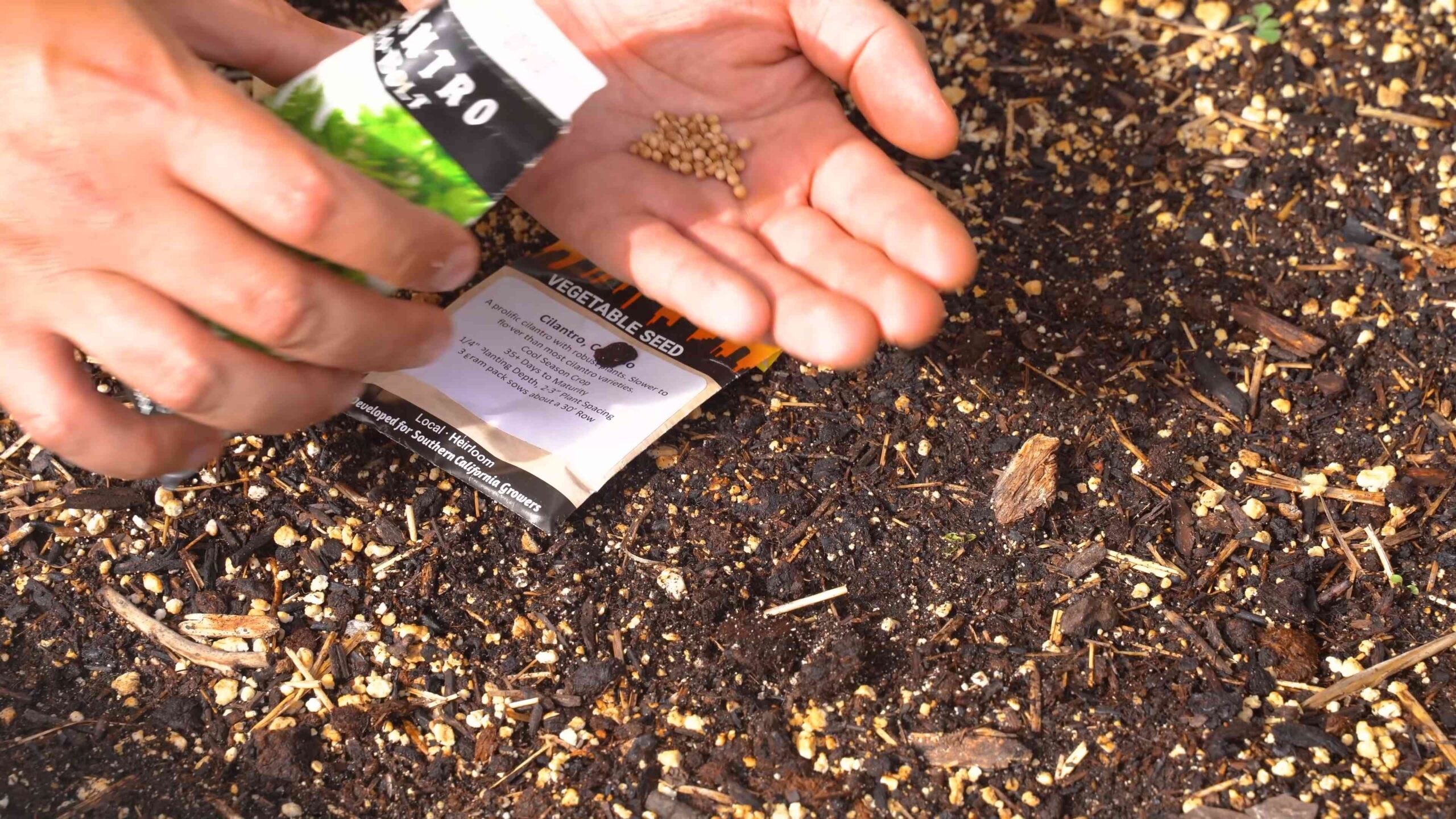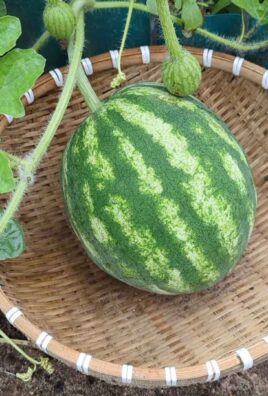Grow Your Own Cilantro: Imagine stepping outside your back door and snipping fresh, vibrant cilantro to add a burst of flavor to your tacos, salsa, or even a simple salad. Sounds dreamy, right? Well, it doesn’t have to be just a dream! This DIY guide is your ticket to becoming a cilantro-growing pro, even if you think you have a black thumb.
Cilantro, also known as coriander (the seeds!), has a rich history, dating back thousands of years. Evidence suggests it was used in ancient Egypt and even mentioned in the Bible. For centuries, cultures around the world have cherished cilantro for its culinary and medicinal properties. But let’s be honest, buying cilantro at the grocery store can be a gamble. Sometimes it’s wilted, sometimes it’s expensive, and sometimes it just doesn’t have that fresh, zesty flavor you’re craving.
That’s where this DIY trick comes in! I’m going to show you how easy it is to grow your own cilantro at home, saving you money and ensuring you always have a supply of fresh, flavorful herbs at your fingertips. Whether you have a sprawling garden or just a sunny windowsill, I’ll guide you through the simple steps to cultivate your own thriving cilantro patch. Get ready to ditch the store-bought bunches and embrace the joy of homegrown goodness!

Grow Your Own Cilantro: A Beginner’s Guide
Hey there, fellow herb enthusiasts! Are you tired of buying cilantro that wilts in your fridge before you even get a chance to use it? I know I was! That’s why I decided to take matters into my own hands and start growing my own. And guess what? It’s way easier than you might think! This guide will walk you through everything you need to know to cultivate a thriving cilantro patch right in your own home or garden. Let’s get started!
What You’ll Need
Before we dive into the nitty-gritty, let’s gather our supplies. Here’s a list of everything you’ll need to successfully grow your own cilantro:
- Cilantro Seeds: You can find these at most garden centers or online. Make sure you’re getting cilantro seeds, not coriander seeds (they come from the same plant, but we want the leaves!).
- Potting Soil: Use a well-draining potting mix. Avoid using garden soil directly in containers, as it can become compacted and hinder drainage.
- Container: Choose a pot that’s at least 6 inches deep and wide. Cilantro has a taproot, so it needs room to grow downwards.
- Watering Can or Hose: For gentle watering.
- Sunlight: Cilantro needs at least 4-6 hours of sunlight per day. A sunny windowsill or a spot in your garden will work perfectly.
- Optional: Seed starting tray, grow light (if you don’t have enough natural sunlight), fertilizer (organic is best!).
Getting Started: Planting Your Cilantro Seeds
Okay, now for the fun part! Planting your cilantro seeds is a simple process, but following these steps will ensure the best results.
- Prepare Your Container: Fill your chosen container with potting soil, leaving about an inch of space at the top. Gently pat down the soil to create a firm surface.
- Sow the Seeds: Cilantro seeds are relatively large, so you can easily space them out. Sprinkle the seeds evenly over the surface of the soil. I usually aim for about 10-15 seeds per 6-inch pot.
- Cover the Seeds: Lightly cover the seeds with about ¼ inch of soil. Cilantro needs darkness to germinate, so don’t skip this step!
- Water Gently: Use a watering can or hose with a gentle spray nozzle to thoroughly moisten the soil. Be careful not to dislodge the seeds.
- Find a Sunny Spot: Place your container in a location that receives at least 4-6 hours of sunlight per day. If you’re growing indoors and don’t have enough natural light, consider using a grow light.
Germination and Early Growth
This is where the patience comes in! Cilantro seeds typically germinate within 7-10 days, but it can sometimes take longer depending on the temperature and moisture levels.
- Keep the Soil Moist: During the germination period, it’s crucial to keep the soil consistently moist. Check the soil daily and water whenever the top inch feels dry to the touch.
- Monitor for Seedlings: Once the seedlings emerge, you’ll see tiny green sprouts pushing through the soil. This is a sign that your cilantro is on its way!
- Thin the Seedlings (Optional): If you planted your seeds densely, you may need to thin out the seedlings to give them enough room to grow. Once the seedlings have a few sets of true leaves (the leaves that look like miniature cilantro leaves), you can carefully snip off the weaker seedlings at the soil line, leaving about 2-3 inches between the remaining plants. I usually skip this step unless my seedlings are really crowded.
Caring for Your Cilantro Plants
Now that your cilantro plants are growing, it’s important to provide them with the right care to ensure they thrive.
- Watering: Cilantro prefers consistently moist soil, but it doesn’t like to be waterlogged. Water your plants whenever the top inch of soil feels dry. Avoid overwatering, as this can lead to root rot.
- Sunlight: Continue to provide your cilantro plants with at least 4-6 hours of sunlight per day. If you’re growing indoors, rotate the pot regularly to ensure that all sides of the plant receive equal light.
- Fertilizing (Optional): Cilantro doesn’t require a lot of fertilizer, but a light feeding every few weeks can help to promote healthy growth. Use an organic fertilizer diluted to half strength. I like to use fish emulsion or compost tea.
- Pinching Back: To encourage bushier growth, pinch back the tips of the stems when the plants are about 4-6 inches tall. This will encourage the plants to produce more side shoots, resulting in a fuller, more productive cilantro patch.
Preventing Bolting
One of the biggest challenges with growing cilantro is that it tends to bolt (go to seed) quickly, especially in hot weather. Bolting causes the leaves to become bitter and less flavorful. Here are some tips to prevent bolting:
- Provide Shade: If you live in a hot climate, provide your cilantro plants with some afternoon shade to protect them from the intense heat. You can use shade cloth or move the plants to a cooler location.
- Water Regularly: Consistent watering is crucial to prevent bolting. Dry soil can stress the plants and trigger them to go to seed.
- Harvest Regularly: Harvesting the leaves regularly will also help to prevent bolting. When you harvest, cut the stems just above a leaf node. This will encourage the plant to produce new growth.
- Choose Bolt-Resistant Varieties: Some cilantro varieties are more resistant to bolting than others. Look for varieties like ‘Slow Bolt’ or ‘Santo’ when purchasing seeds.
Harvesting Your Cilantro
The best part of growing your own cilantro is, of course, harvesting it! You can start harvesting the leaves when the plants are about 6-8 inches tall.
- Harvesting Technique: Use scissors or pruning shears to cut the stems just above a leaf node. Avoid cutting more than one-third of the plant at a time, as this can stress the plant and slow down its growth.
- Harvesting Frequency: Harvest your cilantro regularly to encourage continued growth and prevent bolting. You can harvest as often as you need to, but try to avoid harvesting too much at once.
- Storing Your Harvest: Freshly harvested cilantro is best used immediately, but you can also store it in the refrigerator for a few days. To store cilantro, wrap the stems in a damp paper towel and place them in a plastic bag or container. You can also freeze cilantro for longer storage. To freeze cilantro, chop it up and place it in ice cube trays with water or olive oil. Once frozen, transfer the cubes to a freezer bag.
Troubleshooting Common Problems
Even with the best care, you may encounter some problems while growing your cilantro. Here are some common issues and how to address them:
- Yellowing Leaves: Yellowing leaves can be a sign of overwatering, underwatering, or nutrient deficiency. Check the soil moisture and adjust your watering accordingly. If the soil is consistently moist, you may be overwatering. If the soil is dry, you may be underwatering. If the leaves are yellowing all over, it could be a sign of nutrient deficiency. Try fertilizing with a balanced organic fertilizer.
- Leggy Growth: Leggy growth (long, spindly stems) is usually a sign of insufficient sunlight. Move your plants to a sunnier location or supplement with a grow light.
- Pests: Cilantro is generally pest-resistant, but it can sometimes be affected by aphids or spider mites. If you notice pests on your plants, try spraying them with a strong stream of water or using an insecticidal soap.
- Bolting: As mentioned earlier, bolting is a common problem with cilantro. Follow the tips above to prevent bolting. If your cilantro does bolt, you can still harvest the seeds (coriander) for use in cooking.
Successive Planting for a Continuous Harvest
Cilantro is a short-lived herb, so to ensure a continuous harvest, it’s best to practice successive planting. This means planting new seeds every 2-3 weeks.
- Start New Seeds: Every 2-3 weeks, sow a new batch of cilantro seeds in a separate container.
- Transplant (Optional): Once the seedlings have a few sets of true leaves, you can transplant them into your main cilantro patch or into individual pots.
- Replace Old Plants: As your older cilantro plants start to bolt or become less productive

Conclusion
So, there you have it! Growing your own cilantro isn’t just a fun gardening project; it’s a game-changer for your kitchen. Forget those wilted, expensive bunches from the grocery store. With a little effort, you can have a constant supply of fresh, vibrant cilantro right at your fingertips. The difference in flavor between store-bought and homegrown is truly remarkable – the aroma is more intense, the taste is brighter, and the satisfaction of using something you nurtured yourself is unparalleled.
This DIY cilantro growing trick is a must-try for several reasons. First, it’s incredibly cost-effective. A single packet of cilantro seeds is far cheaper than repeatedly buying bunches from the store, especially if you use the coriander seeds you already have in your spice rack. Second, it’s sustainable. You’re reducing your reliance on commercially grown produce, which often involves long transportation distances and potentially harmful pesticides. Third, it’s convenient. Imagine being able to snip fresh cilantro whenever you need it, without having to make a special trip to the store.
But the best reason to try this is the sheer joy of watching something grow. There’s a unique satisfaction in nurturing a plant from seed to harvest, and cilantro is a relatively easy and rewarding herb to cultivate.
Looking for variations? Consider these ideas:
* **Succession Planting:** Plant a new batch of seeds every few weeks to ensure a continuous harvest throughout the growing season. This is especially important because cilantro tends to bolt (go to seed) quickly in hot weather.
* **Container Gardening:** If you don’t have a garden, don’t worry! Cilantro thrives in containers, making it perfect for balconies, patios, or even a sunny windowsill. Just make sure your container has good drainage.
* **Hydroponics:** For the adventurous gardener, try growing cilantro hydroponically. This method involves growing plants without soil, using nutrient-rich water solutions. It can be a fun and efficient way to produce herbs indoors.
* **Different Varieties:** Explore different varieties of cilantro seeds. Some are more heat-tolerant than others, which can be beneficial if you live in a warmer climate. Look for varieties specifically bred for slower bolting.
* **Cilantro Pesto:** When you have an abundance of cilantro, turn it into a delicious pesto. Combine it with garlic, pine nuts, Parmesan cheese, and olive oil for a vibrant and flavorful sauce that’s perfect for pasta, sandwiches, or grilled meats.
* **Cilantro Lime Rice:** Add freshly chopped cilantro and lime juice to your cooked rice for a simple yet flavorful side dish. This is a classic pairing that complements many cuisines.
* **Cilantro Salsa:** Make a fresh and zesty salsa with cilantro, tomatoes, onions, jalapenos, and lime juice. This is a great addition to tacos, nachos, or grilled fish.We’re confident that you’ll love growing your own cilantro. It’s a simple, rewarding, and delicious way to enhance your culinary creations. So, grab some seeds, get your hands dirty, and experience the joy of homegrown flavor.
Don’t forget to share your experiences with us! We’d love to hear about your successes, challenges, and creative ways you’re using your homegrown cilantro. Post photos of your cilantro plants, share your favorite recipes, and let us know what you’ve learned along the way. Together, we can create a community of cilantro enthusiasts and inspire others to embrace the joys of gardening. Let us know if this DIY cilantro growing trick worked for you!
Frequently Asked Questions (FAQ)
Why is my cilantro bolting (going to seed) so quickly?
Bolting is a common issue with cilantro, especially in hot weather. Cilantro is a cool-season herb, and when temperatures rise, it tends to focus on reproduction rather than leaf production. To prevent bolting, try these tips:
* **Plant in partial shade:** Provide some afternoon shade to protect your cilantro from the hottest sun.
* **Water regularly:** Keep the soil consistently moist, but not waterlogged. Dry soil can stress the plant and trigger bolting.
* **Succession planting:** Plant new seeds every few weeks to ensure a continuous harvest.
* **Choose bolt-resistant varieties:** Some cilantro varieties are specifically bred to be more resistant to bolting.
* **Harvest frequently:** Regular harvesting encourages the plant to produce more leaves and delays bolting.How often should I water my cilantro?
Cilantro needs consistent moisture to thrive. Water deeply whenever the top inch of soil feels dry to the touch. Avoid overwatering, as this can lead to root rot. In hot weather, you may need to water more frequently. A good rule of thumb is to check the soil moisture daily and water as needed.
What kind of soil is best for growing cilantro?
Cilantro prefers well-draining soil that is rich in organic matter. A good potting mix or garden soil amended with compost is ideal. Avoid heavy clay soils, as they can retain too much moisture and lead to root rot. The ideal pH for cilantro is between 6.0 and 7.0.
How much sunlight does cilantro need?
Cilantro needs at least 4-6 hours of sunlight per day. However, in hot climates, it benefits from some afternoon shade. Too much direct sunlight can cause the leaves to burn and the plant to bolt prematurely. If you’re growing cilantro indoors, place it near a sunny window or use a grow light.
Can I grow cilantro indoors?
Yes, cilantro can be successfully grown indoors. Choose a sunny windowsill or use a grow light to provide adequate light. Use a well-draining potting mix and water regularly. Make sure your container has drainage holes to prevent waterlogging. Indoor cilantro may not grow as quickly as outdoor cilantro, but you can still enjoy a fresh supply of herbs year-round.
How do I harvest cilantro?
Harvest cilantro by snipping off the outer leaves with scissors or pruning shears. Avoid cutting the main stem, as this can stunt the plant’s growth. Regular harvesting encourages the plant to produce more leaves. You can harvest cilantro when the plants are about 6-8 inches tall.
What can I do with cilantro seeds (coriander)?
When your cilantro plant bolts, it will produce seeds, which are known as coriander. You can harvest these seeds and use them as a spice in your cooking. Coriander has a warm, citrusy flavor that complements many dishes. You can also save the seeds to plant more cilantro.
My cilantro leaves are turning yellow. What’s wrong?
Yellowing leaves can be a sign of several problems, including overwatering, underwatering, nutrient deficiency, or pest infestation. Check the soil moisture and adjust your watering accordingly. If the soil is consistently wet, you may be overwatering. If the soil is dry, you may need to water more frequently. You can also try fertilizing your cilantro with a balanced fertilizer to provide essential nutrients. Inspect the leaves for pests, such as aphids or spider mites, and treat them accordingly.
How do I store cilantro after harvesting?
To store cilantro, rinse it gently and pat it dry with a paper towel. Wrap the cilantro loosely in a damp paper towel and place it in a plastic bag or container. Store it in the refrigerator. This will help keep the cilantro fresh for several days. You can also freeze cilantro by chopping it and placing it in ice cube trays with water or olive oil. Once frozen, transfer the cubes to a freezer bag.
Is cilantro the same as coriander?
Yes and no. “Cilantro” refers to the leaves and stems of the *Coriandrum sativum* plant, while “coriander” refers to the seeds of the same plant. So, they come from the same plant, but they are different parts with distinct flavors. In some parts of the world, particularly in Europe, the entire plant is referred to as coriander.





Leave a Comment